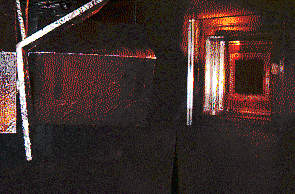
Dual Mode Stirred Chamber set up showing test fixture
The Use of Mode Stirred Chambers For Characterising The Shielding Effectiveness Of RF Gaskets and Materials.G D M Barber SAS Dept, EMH&P Group, DERA, Farnborough |
The measurement of shielding effectiveness has been a subject under investigation for many years. Traditionally shielding effectiveness measurements were carried out in accordance with specifications such as Military Standard 285 written in the 1950's. Military standard 285 was originally designed to measure the performance of shielded rooms at discrete frequencies, the technique was later adopted for the measurement of both rf gaskets and other shielding materials. The use of these standards have produced both unrealistic and unrepeatable shielding effectiveness measurements.
The DERA at Farnborough have been investigating an alternative technique in conjunction with the Naval Surface Warfare Center (NSWC), Dahlgren, Va, USA. The technique under investigation at DERA employs two adjacent mode stirred chambers for evaluating rf gaskets and other shielding materials, providing a more representative and repeatable measurement of shielding effectiveness. The mode stirred technique employed at DERA is known as the 'Dual' mode stirred chamber shielding effectiveness technique.
The EMH&P group at DERA have two adjacent mode stirred chambers with a 1 metre test fixture installed. Shielding effectiveness measurements can be made with sample materials retained in fixtures between the two mode stirred chambers. Both chambers have large 'paddle' wheels installed that can be rotated independently to generate a 'time averaged' uniform field (+/- 3dB) within the chambers from approximately 100 MHz - 18 GHz. Gasket and material samples are therefore exposed to a multiple aspect angle/polarisation field over one rotation of the mode stirred paddle wheel.
The lowest useable frequency of the mode stirred shielding effectiveness test is dependent upon the dimensions of the smaller of the two mode stirred chambers. We obtain a field uniformity of +/- 3 dB from a frequency of approximately 120 MHz. The following schematic shows a simple set up of the 'dual' mode stirred chambers for carrying out shielding effectiveness testing.

Dual Mode Stirred Chamber set up showing test fixture
The set-up and operation of the mode stirred chambers is not discussed in detail within this article. There are papers available which discuss in detail the operation of the mode stirred chambers and the measurement parameters employed in evaluating chamber performance. The picture below shows the set up of the test fixture and mode stirred chambers at DERA, Farnborough.

Picture showing mode stir paddle wheel and test fixture
The 'Dual' mode stirred chamber shielding effectiveness technique has been employed for measuring the shielding performance of many rf gaskets and materials such as elastomer/knitted mesh gaskets, carbon fibre composites, shielded windows and various joint geometries. The technique produces more reliable test results than those obtained employing techniques based upon Military Standard 285, providing test to test repeatabilities of better than +/- 3 dB. The dual mode stirred chamber approach also provides a measurement of the 'worst case' shielding effectiveness, independent of antenna aspect angle (illumination angle) and polarisation.
Work is being carried out in conjunction with the NSWC to validate the technique. Comparisons are also being made between the mode stirred chamber and measurements based upon transmission and reflection coefficients carried out within coaxial measurement jigs. These measurements are being carried out from several kHz to approximately 2 GHz, comparisons between the mode stirred and coaxial jig results look encouraging, providing measurement correlation of typically +/- 2-3 dB.
The measurement technique developed at DERA utilises custom software written using Visual basic to capture and process the swept shielding effectiveness data.

Typical shielding effectiveness results for joint overlaps and rf gasket materials.
A typical measurement of a composite sample panel is shown in the figure below. This figure shows the shielding performance of a typical composite panel sample measured within the mode stirred chamber. In addition this figure shows the maximum baseline or isolation measured with a continuous metal calibration panel placed in the test fixture.

Typical shielding effectiveness result for a composite panel sample.
The 'dual' mode stirred shielding effectiveness measurement technique has proved to be a useful 'tool' in the evaluation of both rf gasket and other shielding materials. The technique provides 'good' test to test repeatabilities, typically +/- 3dB. The technique is less time consuming than standard measurement techniques, a typical measurement from 100 MHz - 18 GHz taking approximately 2 hours to complete. The frequency range 100 MHz - 18 GHz is typically divided into 8 frequency runs, dependent upon antenna and amplifier bandwidths. Typically over 6000 data points are taken during one sample measurement.
Work is continuing at DERA to derive a test technique for the evaluation of shielded cable assemblies, employing the mode stirred chamber technique. An additional article will be produced in the near future to discuss the cable shield measurement technique.
 © Nutwood UK Ltd 2001 |
Eddystone Court - De Lank Lane St Breward - BODMIN - PL30 4NQ Tel: +44 (0)1208 851530 - Fax: +44 (0)1208 850871 nutwooduk@nutwood.eu.com |
|
|
|